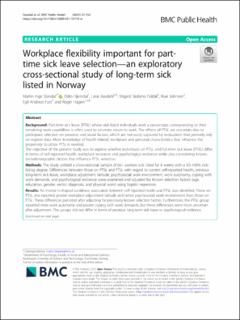| dc.contributor.author | Standal, Martin Inge | |
| dc.contributor.author | Hjemdal, Odin | |
| dc.contributor.author | Aasdahl, Lene | |
| dc.contributor.author | Foldal, Vegard Stolsmo | |
| dc.contributor.author | Johnsen, Roar | |
| dc.contributor.author | Fors, Egil Andreas | |
| dc.contributor.author | Hagen, Roger | |
| dc.date.accessioned | 2021-04-28T07:22:21Z | |
| dc.date.available | 2021-04-28T07:22:21Z | |
| dc.date.created | 2021-04-27T09:06:15Z | |
| dc.date.issued | 2021 | |
| dc.identifier.citation | BMC Public Health. 2021, 21, . | en_US |
| dc.identifier.issn | 1471-2458 | |
| dc.identifier.uri | https://hdl.handle.net/11250/2740031 | |
| dc.description.abstract | Background
Part-time sick leave (PTSL) where sick-listed individuals work a percentage corresponding to their remaining work capabilities is often used to promote return to work. The effects of PTSL are uncertain due to participant selection on personal and social factors, which are not easily captured by evaluations that primarily rely on register-data. More knowledge of health-related, workplace and personal characteristics that influence the propensity to utilize PTSL is needed.
The objective of the present study was to explore whether individuals on PTSL and full-time sick leave (FTSL) differ in terms of self-reported health, workplace resources and psychological resilience while also considering known sociodemographic factors that influence PTSL selection.
Methods
The study utilized a cross-sectional sample of 661 workers sick listed for 8 weeks with a 50–100% sick-listing degree. Differences between those on PTSL and FTSL with regard to current self-reported health, previous long-term sick leave, workplace adjustment latitude, psychosocial work environment, work autonomy, coping with work demands, and psychological resilience were examined and adjusted for known selection factors (age, education, gender, sector, diagnosis, and physical work) using logistic regression.
Results
An inverse U-shaped curvilinear association between self-reported health and PTSL was identified. Those on PTSL also reported greater workplace adjustment latitude and better psychosocial work environment than those on FTSL. These differences persisted after adjusting for previously known selection factors. Furthermore, the PTSL group reported more work autonomy and poorer coping with work demands, but these differences were more uncertain after adjustment. The groups did not differ in terms of previous long-term sick leave or psychological resilience.
Conclusion
The present study found differences between those on PTSL and FTSL with regards to self-reported health, workplace adjustment latitude and psychosocial work environment that were independent of differences identified in previous research. These results are important for future evaluations of the effect of PTSL on RTW, suggesting more attention should be paid to self-reported health status and workplace characteristics that are not captured using register data. | en_US |
| dc.language.iso | eng | en_US |
| dc.publisher | BioMed Central | en_US |
| dc.rights | Navngivelse 4.0 Internasjonal | * |
| dc.rights.uri | http://creativecommons.org/licenses/by/4.0/deed.no | * |
| dc.title | Workplace flexibility important for part-time sick leave selection—an exploratory cross-sectional study of long-term sick listed in Norway | en_US |
| dc.type | Peer reviewed | en_US |
| dc.type | Journal article | en_US |
| dc.description.version | publishedVersion | en_US |
| dc.source.volume | 21 | en_US |
| dc.source.journal | BMC Public Health | en_US |
| dc.identifier.doi | 10.1186/s12889-021-10778-w | |
| dc.identifier.cristin | 1906602 | |
| dc.description.localcode | This article is licensed under a Creative Commons Attribution 4.0 International License, which permits use, sharing, adaptation, distribution and reproduction in any medium or format, as long as you give appropriate credit to the original author(s) and the source, provide a link to the Creative Commons licence, and indicate if changes were made. The images or other third party material in this article are included in the article's Creative Commons licence, unless indicated otherwise in a credit line to the material. If material is not included in the article's Creative Commons licence and your intended use is not permitted by statutory regulation or exceeds the permitted use, you will need to obtain permission directly from the copyright holder. To view a copy of this licence, visit http://creativecommons.org/licenses/by/4.0/. The Creative Commons Public Domain Dedication waiver (http://creativecommons.org/publicdomain/zero/1.0/) applies to the data made available in this article, unless otherwise stated in a credit line to the data. | en_US |
| dc.source.articlenumber | 732 | en_US |
| cristin.ispublished | true | |
| cristin.fulltext | original | |
| cristin.qualitycode | 1 | |

